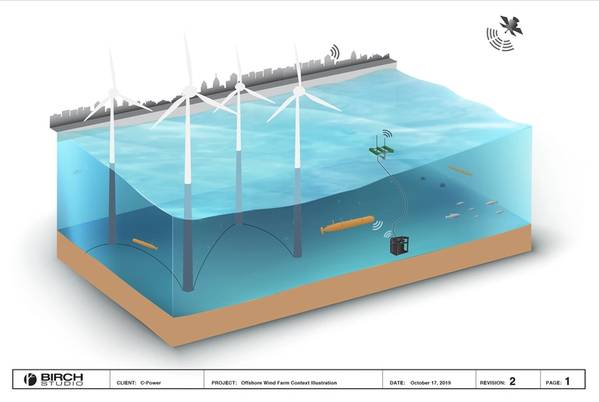
With the advent of autonomy on and under the water, part of the value proposition is the ability to stay at sea, on station, to exponentially increase efficiencies. Have the ability to repower at sea is central to this effort, as an increasing number of companies work to solve the inherent technical and logistic problems.
Columbia Power Technologies (C-Power) is commencing a six-month sea trial to test and validate its SeaRAY autonomous offshore power system (AOPS), in partnership with a pair of powerhouses: the U.S. Department of Energy (DOE) and the U.S. Navy
Initially conceived during a U.S. Department of Defense project, the SeaRAY AOPS is designed to provide in-situ power, energy storage, and real-time data and communications support that is intended to advance the marine economy toward a future of autonomous, connected and resident technologies. It is designed to support unmanned offshore activities, including subsea vehicles, sensor packages, and operating equipment.
“The ocean is a power desert,” said Reenst Lesemann, CEO of C-Power. “Providing reliable power and real-time data communications through an AOPS is critical to unlock the full potential of the marine economy. The SeaRAY delivers these capabilities and enables a future of cheaper, safer, cleaner, more connected offshore operations.”
The sea trials will begin later this year at the Navy’s Wave Energy Testing Site (WETS), located off Marine Corps Base Hawaii on the island of Oahu, Hawaii.
The SeaRAY AOPS at WETS is a moored configuration consisting of a surface wave energy converter; a single, combined mooring, data, communications and power cable; and a seafloor base unit that provides 100 kWh of energy storage for payload operation. The SeaRAY, which will support several payloads during the deployment, has been developed under a $3.2 million DOE-sponsored research and development program.
The SeaRAY AOPS is designed to be scalable to capacities from tens of watts to tens of KW. The AOPS is designed to survive the expected conditions of a 100-year storm off the Oregon coast and is easily transported worldwide in two standard ocean containers. It will be deployed at WETS with a small, lightly-crewed vessel.
C-Power’s technology partners for the sea trials include EC-OG, RigNet, EOM Offshore and Saab Group.
The SeaRAY’s seafloor base unit will be provided by EC-OG. EC-OG’s 100-kWh Halo lithium-ion battery energy storage system is designed for the harsh subsea environment and will be fully integrated with the AOPS, providing the payload interfaces for power, data and communications.
Following completion of the WETS sea trials, C-Power expects to complete commercial launch of the SeaRAY in 2021.